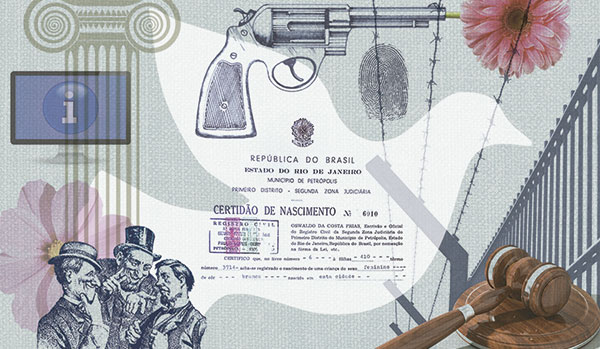[Retratos] SDG 16: Peace, justice and strong institutions
November 07, 2017 09h00 AM | Last Updated: November 08, 2017 11h30 AM
Significantly reduce all forms of violence; reduce corruption and bribery in all their forms; provide legal identity for all, including birth registration; ensure public access to information and protect fundamental freedoms are some of the SDG 16 targets – theme of our second interview with the IBGE technicians who are in charge of each of the 17 Sustainable Development Goals (SDGs).
Read the interview below - by Retratos Magazine no. 5 - with the IBGE researchers Rosane Oliveira, who holds a Master’s degree in Anthropology, and Leonardo Athias, a PhD in Political Sciences.

Retratos Magazine: SDG 16 mentions several forms of violence, which vary in nature from country to country. What part does Brazil play in this SGD?
Rosane Oliveira: SDG 16 deals with issues related to public security, justice and governance. As for violence, the indicators refer to a number of problems currently faced in Brazil. For example, there are data and methodologies available for the intentional homicide rate and the number of unsentenced prisoners in the overall incarcerated population, two indicators produced by the Ministries of Justice and Health, partners in this work.
Other indicators concerning our reality could only be produced by means of a national victimization survey: the number of persons who feel safe when taking a walk by themselves in the neighborhood and the proportion of victims who report violent occurrences to the police. The IBGE expects to conduct that survey in 2019, in partnership with institutions that work in the field of Justice.
Some other indicators, like “Conflict-related deaths”, do not apply to our country because they refer to war territories. Also, “Number of verified cases of killing, kidnapping, enforced disappearance, arbitrary detention and torture of journalists, associated media personnel, trade unionists and human rights advocates in the previous 12 months” does not apply to our current reality.
Retratos Magazine: What is approached in the discussion about the “Strengthening of relevant national institutions, including through international cooperation, for building capacity at all levels, in particular in developing countries, to prevent violence and combat terrorism and crime”?
Leonardo Athias: There are international cooperation efforts aimed at the strengthening of national institutions, mainly in countries with limited institutional capacity . Such efforts include sending material resources, training, and the work of foreign technicians. Institutions with a capacity for action, monitoring, and that respond to the demand of society tend to be more efficient, I mean, tend to follow their goals and implement policies that benefit the population.
Retratos Magazine: This ODS also refers to “strong institutions”. What are they like?
Rosane: Public institutions can work in different segments, making available detailed reports of meetings and also broadcasting those events by the Internet. In addition to that, Ombudsman Services can provide timely and detailed responses regarding the law of access to information; promote recruitment by means of competitive examinations with vacancies reserved for minorities, which is considered a good practice to ensure diversity of staff. Diversity leads to a bigger capacity of understanding user’s needs.
Retratos Magazine: What indicators does the IBGE have to monitor the current scenario?
Rosane: One indicator that can be produced by the IBGE is “proportion of children under 5 years of age whose births have been registered with civil authority, by age”. But to do that we need a number of calculations currently under analysis by Copis (Department of Population and Social Indicators, Directorate of Surveys of the IBGE).
Retratos Magazine: What are some of the challenges in this theme?
Rosane: The themes of SDG 16 encompass several spheres of knowledge/data production, and the production of information is not centralized. It includes subjective aspects of survey interviewees (feelings of insecurity), checking of administrative records (department of prisons) and the production of indicators from the access to different sources of data and the attempt at their harmonization (traffic of persons).
The main challenge in this case is to work with the big number of bodies in charge of producing information about security, justice and governance. There are 23 indicators and at least 12 producers of information, for example: National Secretariat of Public Security, National Department of Prisons, Office of the Comptroller General, National Treasury Secretariat, Health Surveillance Secretariat and National Council of Justice.
A survey of nationwide coverage – such as the victimization coverage expected for 2019 - is a challenge, but are ready to conduct it in a careful and effective way, as we always do in the IBGE surveys.
Retratos Magazine: What has the IBGE been doing to reach that goal? Can you tell us more about that?
Rosane: Besides the victimization survey, in 2009, we will also have a set of questions about municipal and state governance based on information obtained from Munic (Survey of Basic Municipal Information) and Estadic (Survey of Basic State Information), which will generate useful data for the construction of indicators related to the 2030 Agenda.
Munic/Estadic will enquire about the existence of public policies of information and communication technology (TIC): a city government webpage, availabilty of a government transparency portal, access to information on public accounts, a channel for communication with citizens. The surveys will also investigate the existence of municipal and state councils open to civil society, participatory budgeting, ombudsman services, and other initiatives related to citizen participation in public management.
Text: Marília Loschi
Images: Licia Rubinstein


















